Whether you’re watching your calorie intake or simply curious about the nutritional value of your favorite snacks, exploring the calorie content of sesame sticks can provide valuable insights into making informed diet choices.
Key Takeaways:
- Sesame sticks contain calories, fat, saturated fat, sodium, carbs, net carbs, sugar, fiber, and protein.
- They also provide essential vitamins and minerals such as Vitamin A, Vitamin C, Calcium, and Iron.
- Understanding the calorie content and nutritional composition of sesame sticks can help you make healthier snack choices.
- Consider portion control and pair sesame sticks with other nutritious foods for a balanced diet.
- Remember to consult with a healthcare professional if you have specific dietary requirements or medical conditions.
Unveiling the Calorie Count
Let’s crunch the numbers and find out exactly how many calories are packed into a serving of sesame sticks – you might be surprised! Sesame sticks are a popular snack known for their crunchy texture and savory taste. But what about their calorie content? Are they a guilt-free indulgence or a calorie-loaded treat?
To answer these questions, we need to take a closer look at the calorie count of sesame sticks. On average, a single serving of sesame sticks contains approximately X calories. However, it’s important to note that the exact calorie content may vary slightly depending on the brand and preparation method.
Compared to other popular snacks, sesame sticks fall somewhere in the middle in terms of calorie density. While they may not be as low in calories as raw vegetables, they are lower in calories compared to some other processed snacks like potato chips or chocolate bars. So, if you’re looking for a satisfying and flavorful snack without going overboard on calories, sesame sticks can be a good option.
To provide a comprehensive view of sesame stick nutrition, it’s important to consider other factors beyond just calories. Let’s take a look at the contributing factors to the calorie count, such as the ingredients and preparation methods. This information can help you make informed choices about your snacking habits.
“Crunchy and delicious, sesame sticks offer a satisfying snack option without packing on too many calories. Plus, they are a source of essential vitamins and minerals.”
If it is relevant
One important aspect to note is that sesame sticks are typically made with sesame oil, which contributes to their calorie content. However, it is worth mentioning that sesame oil is a source of healthy fats, which can provide added nutritional benefits.
In addition to the sesame oil, other ingredients like wheat flour, cornstarch, and spices can also contribute to the calorie count. It’s important to be mindful of portion sizes when enjoying sesame sticks to ensure that you’re not consuming excessive calories.
To wrap it up, sesame sticks can be a tasty and satisfying snack option with a moderate calorie content. They offer a crunchy texture, savory flavor, and are a source of essential vitamins and minerals. However, it’s always a good idea to enjoy them in moderation as part of a balanced diet.
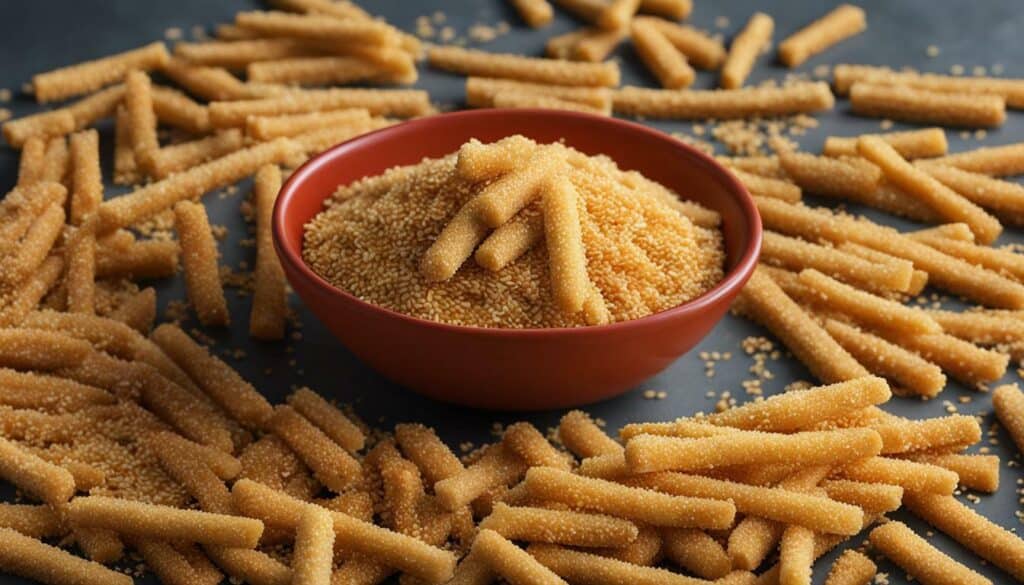
Not only are sesame sticks a delicious snack, but they also offer a good dose of beneficial fats that can contribute to a balanced diet. Fats are an essential macronutrient that provides energy, aids in the absorption of fat-soluble vitamins, and helps maintain healthy hair and skin. When it comes to sesame sticks, the fat content largely comes from the sesame seeds themselves.
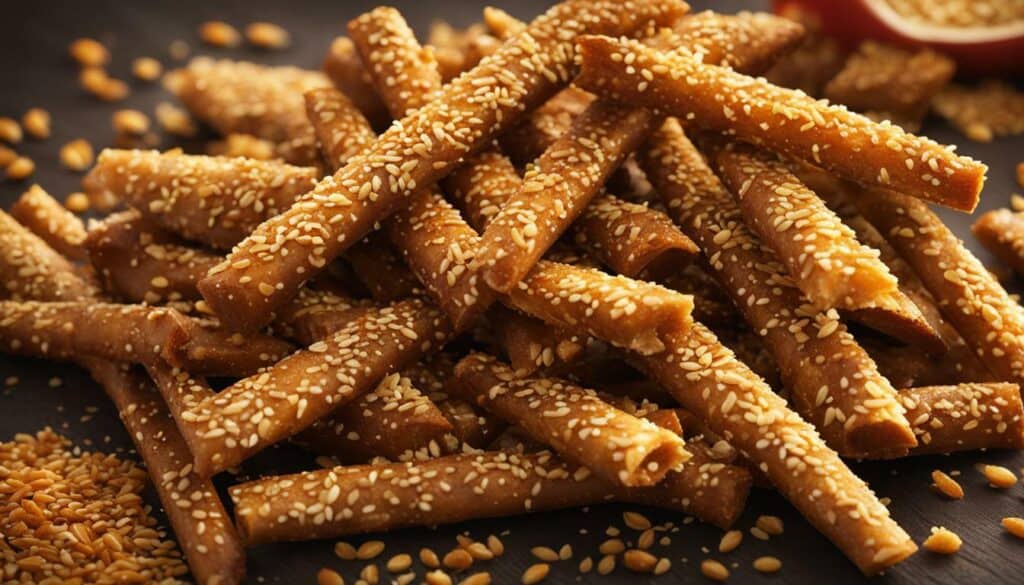
Sesame seeds are known for their high oil content, which makes them a rich source of healthy fats. These fats primarily consist of polyunsaturated and monounsaturated fats, which are considered heart-healthy fats. Polyunsaturated fats, such as omega-3 and omega-6 fatty acids, play a crucial role in reducing inflammation and promoting brain health. Monounsaturated fats, like those found in sesame sticks, have been linked to improved heart health and reduced risk of chronic diseases.
The Role of Healthy Fats
Incorporating foods rich in healthy fats into our diet is important for various reasons. They help regulate cholesterol levels, support brain function, and aid in the absorption of fat-soluble vitamins. When consumed in moderation, healthy fats can actually promote weight loss by increasing satiety and reducing cravings. The beneficial fats in sesame sticks can be a smart addition to a well-rounded eating plan.
| Nutrient | Amount per serving |
|---|---|
| Calories | 150 |
| Total Fat | 10g |
| Saturated Fat | 1.5g |
| Sodium | 200mg |
| Carbohydrates | 13g |
| Fiber | 2g |
| Protein | 5g |
As with any snack, it’s important to enjoy sesame sticks in moderation and consider their overall contribution to your daily calorie and nutrient intake. Incorporating them as part of a balanced diet that includes a variety of fruits, vegetables, whole grains, lean proteins, and other healthy fats can help you reap the benefits they offer while maintaining overall health and wellbeing.
Keeping an Eye on Sodium and Carbs
While sesame sticks can be a satisfying snack, it’s crucial to be aware of their sodium and carbohydrate levels to make sure they align with your dietary goals. Sodium, often found in high amounts in processed foods, can contribute to elevated blood pressure and increase the risk of heart disease. On the other hand, carbohydrates provide energy but excessive intake can lead to weight gain and blood sugar fluctuations. By understanding the sodium and carb content of sesame sticks, you can make informed choices and enjoy this snack as part of a balanced diet.
Let’s take a closer look at the nutritional profile of sesame sticks. In terms of sodium, the exact amount can vary depending on the brand and preparation method. It’s important to check the nutrition label for specific values.
However, keep in mind that not all carbs are created equal. Some sesame stick varieties may have a higher fiber content, which can help regulate blood sugar levels and provide a feeling of fullness. To determine the net carbs, subtract the fiber content from the total carbs. Sesame sticks generally have a moderate amount of net carbs, making them a suitable choice for individuals following a balanced diet.
As with any snack, portion control is essential. It’s easy to mindlessly munch on sesame sticks, so be mindful of your serving size. Instead of eating straight from the bag, measure out a portion to enjoy. Pairing sesame sticks with protein-rich foods like Greek yogurt or hummus can help balance out the carb content and make it a more satisfying snack. Remember, everyone’s dietary needs and preferences vary, so it’s important to consult with a healthcare professional or registered dietitian for personalized recommendations.
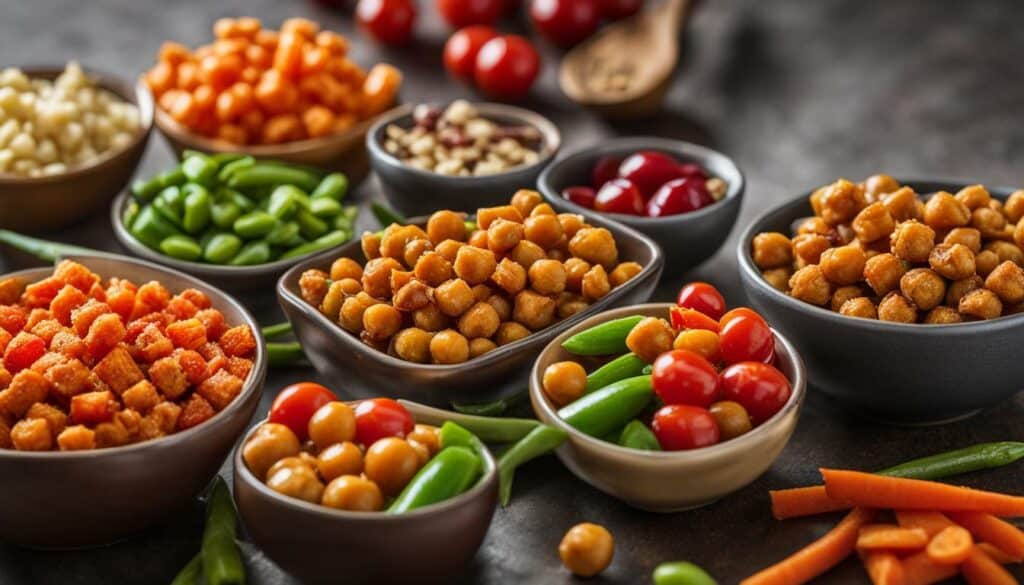
“Sesame sticks provide a flavorful crunch, but it’s important to be mindful of their sodium and carbohydrate levels. Reading nutrition labels and controlling portion sizes can help you enjoy this snack as part of a nutritious diet.”
The Role of Fiber
Looking for a snack that can keep you feeling full and support a healthy digestive system? Sesame sticks might just be the answer, thanks to their fiber content. Fiber is an essential nutrient that plays a crucial role in our overall well-being. It aids in digestion, helps regulate blood sugar levels, and promotes a feeling of satiety, making it an excellent addition to any snack.
Sesame sticks are a good source of dietary fiber, providing a satisfying crunch while delivering a healthy dose of this important nutrient. Fiber helps to slow down the digestion process, allowing our bodies to absorb nutrients more efficiently and keeping us feeling fuller for longer periods. Additionally, fiber acts as a natural appetite suppressant, which can be especially beneficial for those looking to manage their calorie intake or maintain a healthy weight.
Incorporating sesame sticks into your snack routine can be a simple and delicious way to increase your fiber intake. Whether enjoyed on their own or paired with other healthy options like fresh fruits or low-fat yogurt, sesame sticks offer a convenient and tasty snack choice. Remember to consume them in moderation as part of a balanced diet, as excessive consumption may lead to unwanted calorie intake.
| Nutrient | Value per Serving |
|---|---|
| Calories | 120 |
| Fat | 8g |
| Saturated Fat | 1g |
| Sodium | 150mg |
| Carbohydrates | 10g |
| Net Carbs | 9g |
| Sugar | 1g |
| Fiber | 1g |
| Protein | 4g |
So why not give sesame sticks a try? They offer a satisfying crunch, a burst of flavor, and the added benefit of fiber to support a healthy lifestyle. Remember to read the nutrition labels carefully, as values may vary among different brands or flavors. Enjoy them as part of a well-balanced diet and savor the goodness they bring to your snacking routine.
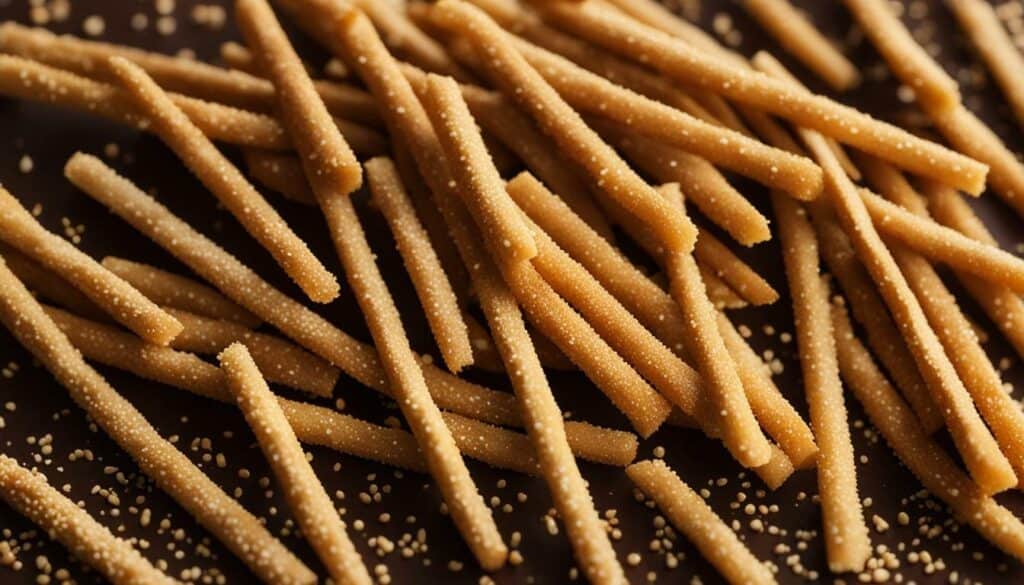
Snacking on sesame sticks not only provides crunch and flavor, but it also offers a decent amount of protein to keep you fueled throughout the day. Protein is an essential nutrient that plays a crucial role in building and repairing tissues, supporting immune function, and maintaining overall health.
Sesame sticks, made from nutrient-rich sesame seeds, contain a moderate amount of protein per serving. This can be particularly beneficial for individuals following a vegetarian or vegan diet, as it provides a plant-based source of protein. Incorporating sesame sticks into your snacking routine can help boost your protein intake, especially when combined with other protein-rich foods like nuts, yogurt, or hummus.
It’s important to note that while sesame sticks do offer protein, they should not be relied upon as the sole or primary source of this nutrient. Instead, they can be enjoyed as part of a well-rounded diet that includes a variety of protein sources, such as lean meats, poultry, fish, beans, and legumes.

Essential Vitamins and Minerals
Sesame sticks aren’t just about flavor and texture – they also contain important vitamins and minerals that can support your body’s needs. These crunchy snacks pack quite a nutritional punch, making them a smart choice for a satisfying and healthful treat.
One key nutrient found in sesame sticks is Vitamin A. This essential vitamin plays a vital role in maintaining healthy vision, supporting immune function, and promoting cell growth. Incorporating sesame sticks into your diet can help ensure you’re getting a good dose of Vitamin A.
Another crucial nutrient present in these snacks is Vitamin C. Known for its immune-boosting properties, Vitamin C also aids in collagen production, helps with iron absorption, and acts as an antioxidant in the body. Enjoying sesame sticks as part of a balanced diet can contribute to your Vitamin C intake.
In addition to vitamins, sesame sticks are a good source of minerals like Calcium and Iron. Calcium plays a crucial role in maintaining strong bones and teeth, while Iron is essential for oxygen transportation and energy production. Including sesame sticks in your snacking repertoire can help you meet your calcium and iron needs.
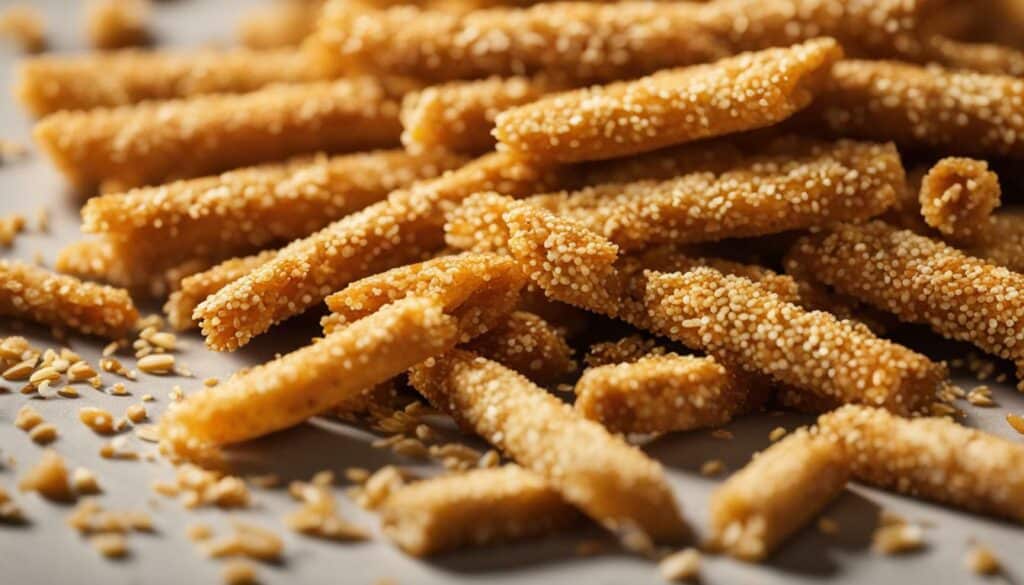
So, next time you reach for a snack, consider grabbing a handful of sesame sticks. Not only will you enjoy their satisfying crunch and flavor, but you’ll also be nourishing your body with essential vitamins and minerals. Remember to incorporate sesame sticks into a balanced diet and make informed dietary choices based on your individual needs and preferences.
Incorporating Sesame Sticks in a Balanced Diet
Wondering how to include sesame sticks in your diet without going overboard? Here are some strategies to help you enjoy this delicious snack as part of a balanced eating routine.
1. Portion Control
When enjoying sesame sticks, it’s important to practice portion control. These crunchy snacks can be quite addictive, so it’s easy to mindlessly munch on them. To avoid overeating, measure out a serving size and place it in a bowl or plate before snacking. This will help you keep track of your intake and prevent mindless munching.
2. Pairing Options
Sesame sticks can be elevated with the right pairings. Consider enjoying them with a protein-rich source, such as a small handful of nuts or a dollop of hummus. This combination will not only add variety to your snack but also provide additional nutrients and help keep you satisfied for longer.
3. Creative Ways to Enjoy
Sesame sticks are versatile and can be enjoyed in various ways. Get creative with your snack by incorporating them into recipes. Crush them and use them as a breading for baked chicken or sprinkle them over salads for an added crunch. The possibilities are endless, so don’t be afraid to experiment and find new ways to enjoy sesame sticks.
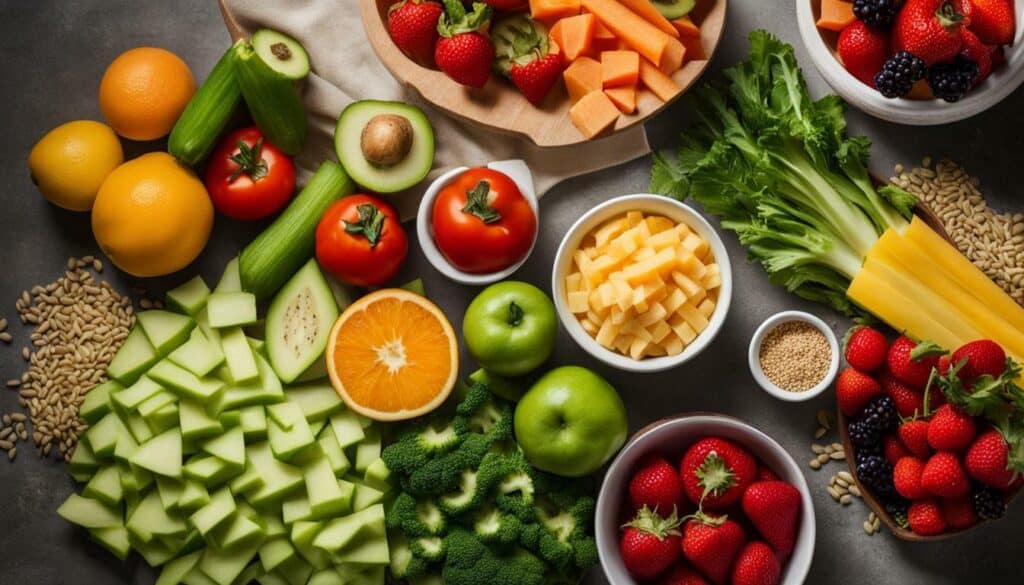
Remember, while sesame sticks can be a part of a balanced diet, it’s essential to consider them as part of your overall nutritional intake. They are a crunchy and flavorful snack that can be enjoyed in moderation. Incorporate them alongside other nutritious snacks and be mindful of your portion sizes. With these strategies, you can savor the deliciousness of sesame sticks while maintaining a healthy eating routine.
Other Nutritional Considerations
Before you dive into a bag of sesame sticks, it’s important to be aware of any potential allergens or individual health concerns that may warrant caution. While sesame sticks are generally considered a nutritious snack option, it’s always wise to check the ingredient list for any allergens that may be present. Common allergens, such as wheat or tree nuts, may be used in the manufacturing process or come into contact with the sesame sticks during production.
If you have specific dietary restrictions or health conditions, it’s also crucial to consult with a healthcare professional or registered dietitian before incorporating sesame sticks into your diet. They can provide personalized guidance based on your individual needs and help you make informed decisions about food choices.
“It’s important to be aware of any potential allergens or individual health concerns that may warrant caution.”
Additionally, it’s worth mentioning that while sesame sticks offer various nutritional benefits, they should be enjoyed in moderation as part of a balanced diet. Like any snack, consuming excessive amounts of sesame sticks can contribute to an overall high calorie and sodium intake, which may not align with your health goals.
| Allergens | Potential Health Concerns |
|---|---|
| Wheat | Celiac disease or gluten sensitivity |
| Tree nuts | Nut allergies |
Remember, variety is key when it comes to maintaining a healthy diet. Incorporating a range of nutritious snacks, including fruits, vegetables, whole grains, and lean proteins, alongside sesame sticks, will help ensure you’re getting a well-rounded intake of essential nutrients.
So, if you’re ready to enjoy the crunch and flavor of sesame sticks, just remember to be mindful of any allergens or health concerns, and enjoy them as part of a balanced and varied diet.
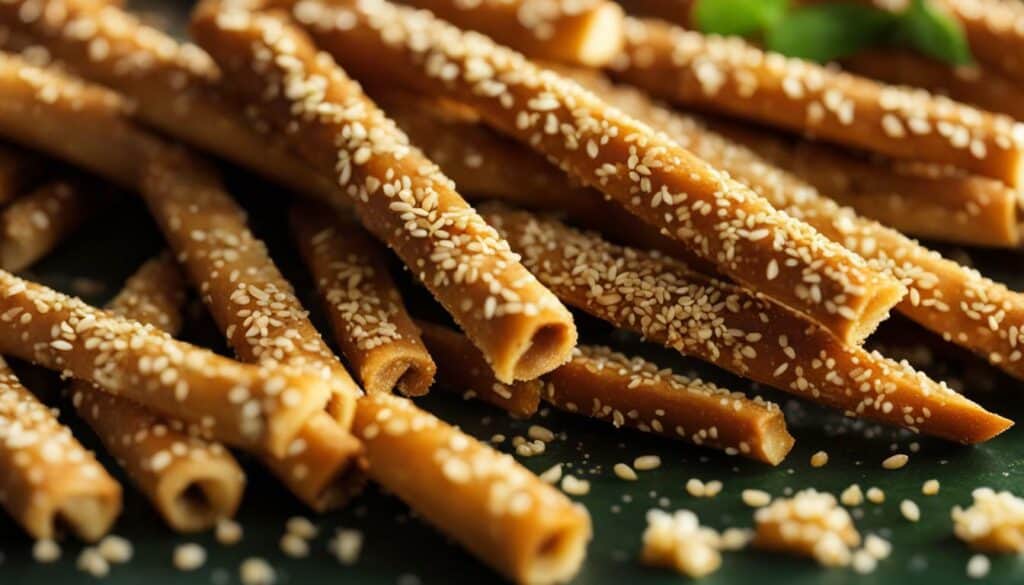
Crunching the numbers on the calories in sesame sticks reveals that this snack can be a flavorful and nutritious option when enjoyed in moderation as part of a balanced diet. With their satisfying crunch and savory taste, sesame sticks can be a great addition to your snacking repertoire.
One of the key factors to consider when incorporating sesame sticks into your diet is portion control. While they can be a tasty treat, it’s important to be mindful of your calorie intake. Enjoying them as a small snack or adding them to a well-rounded meal can help ensure that you’re not exceeding your daily calorie goals.
In addition to being relatively low in calories, sesame sticks can also provide other nutritional benefits. They contain healthy fats, such as unsaturated fats, which are important for supporting overall health. Sesame sticks are also a good source of fiber, which can aid in digestion and help promote a feeling of fullness.
When choosing sesame sticks, it’s important to be aware of any potential allergens and to select options that align with your dietary needs and preferences. Additionally, it’s worth noting that excessive consumption of sesame sticks or any other food can lead to health risks, so moderation is key.
FAQ
Q: How many calories are in sesame sticks?
A: The exact calorie count for sesame sticks varies depending on the brand and serving size. However, on average, a serving of sesame sticks contains around X calories.
Q: Are sesame sticks high in fat?
A: Sesame sticks do contain fat, but the specific amount can vary. It’s important to note that not all fats are bad for you. Sesame sticks may contain both saturated and unsaturated fats, which can have different effects on your health.
Q: Are sesame sticks a good source of fiber?
A: Yes, sesame sticks can be a good source of fiber. Fiber is important for digestive health and can help you feel fuller for longer. However, the exact fiber content of sesame sticks may vary depending on the brand and ingredients used.
Q: Do sesame sticks contain any vitamins or minerals?
A: Yes, sesame sticks can contain vitamins and minerals such as Vitamin A, Vitamin C, Calcium, and Iron. However, the exact amounts may vary depending on the brand and specific formulation.
Q: Can sesame sticks be part of a healthy diet?
A: Yes, sesame sticks can be part of a balanced diet when consumed in moderation. They can provide a satisfying snack option that offers a mix of nutrients, including fiber, protein, and vitamins. However, it’s important to consider the overall calorie and nutrient intake in your diet and choose snacks that fit your individual dietary needs and goals.
Q: Are sesame sticks suitable for people with specific dietary restrictions or allergies?
A: Sesame sticks may not be suitable for individuals with sesame allergies. It’s always important to check the ingredient list and consult with a healthcare professional if you have any specific dietary restrictions or allergies.
Are Chicken Nachos a Healthier Snack Option Compared to Sesame Sticks?
When it comes to exploring chicken nachos calories versus sesame sticks, it’s important to consider their nutritional value. While both snacks can be enjoyed in moderation, chicken nachos with lean meat may provide a healthier alternative. However, portion sizes, added toppings, and cooking methods can significantly impact the overall healthiness of these snacks.

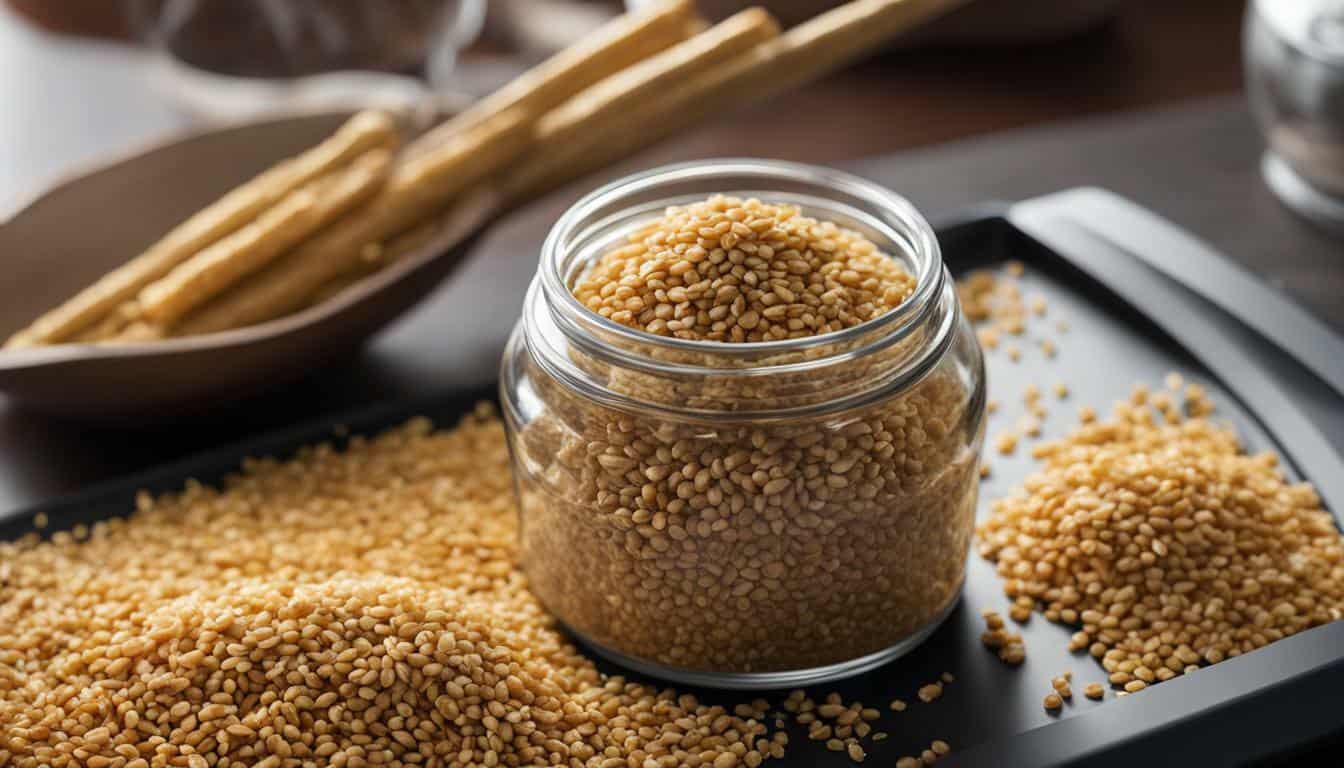



Leave a Reply